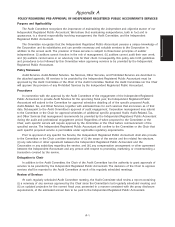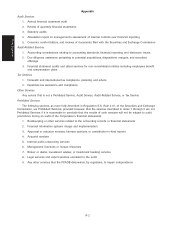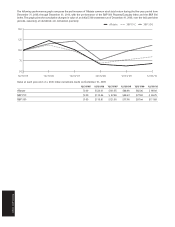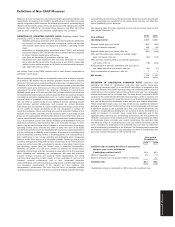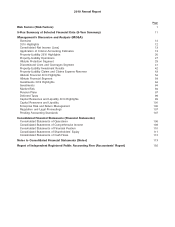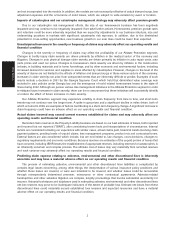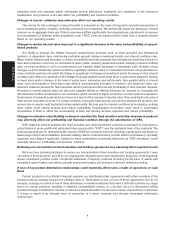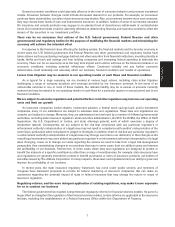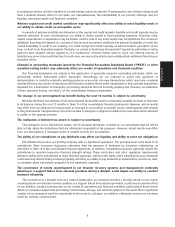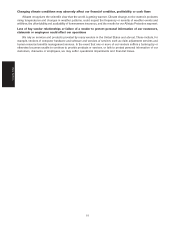Allstate 2011 Annual Report Download - page 81
Download and view the complete annual report
Please find page 81 of the 2011 Allstate annual report below. You can navigate through the pages in the report by either clicking on the pages listed below, or by using the keyword search tool below to find specific information within the annual report.
RISK FACTORS
This document contains ‘‘forward-looking statements’’ that anticipate results based on our estimates, assumptions
and plans that are subject to uncertainty. These statements are made subject to the safe-harbor provisions of the Private
Securities Litigation Reform Act of 1995. We assume no obligation to update any forward-looking statements as a result
of new information or future events or developments.
These forward-looking statements do not relate strictly to historical or current facts and may be identified by their
use of words like ‘‘plans,’’ ‘‘seeks,’’ ‘‘expects,’’ ‘‘will,’’ ‘‘should,’’ ‘‘anticipates,’’ ‘‘estimates,’’ ‘‘intends,’’ ‘‘believes,’’ ‘‘likely,’’
‘‘targets’’ and other words with similar meanings. These statements may address, among other things, our strategy for
growth, catastrophe exposure management, product development, investment results, regulatory approvals, market
position, expenses, financial results, litigation and reserves. We believe that these statements are based on reasonable
estimates, assumptions and plans. However, if the estimates, assumptions or plans underlying the forward-looking
statements prove inaccurate or if other risks or uncertainties arise, actual results could differ materially from those
communicated in these forward-looking statements.
In addition to the normal risks of business, we are subject to significant risks and uncertainties, including those
listed below, which apply to us as an insurer and a provider of other financial services. These risks constitute our
cautionary statements under the Private Securities Litigation Reform Act of 1995 and readers should carefully review
such cautionary statements as they identify certain important factors that could cause actual results to differ materially
from those in the forward-looking statements and historical trends. These cautionary statements are not exclusive and
are in addition to other factors discussed elsewhere in this document, in our filings with the Securities and Exchange
Commission (‘‘SEC’’) or in materials incorporated therein by reference.
Risks Relating to the Property-Liability business
As a property and casualty insurer, we may face significant losses from catastrophes and severe weather
events
Because of the exposure of our property and casualty business to catastrophic events, our operating results and
financial condition may vary significantly from one period to the next. Catastrophes can be caused by various natural
and man-made disasters, including earthquakes, volcanoes, wildfires, tornadoes, hurricanes, tropical storms and
certain types of terrorism. We may incur catastrophe losses in our auto and property business in excess of: (1) those
experienced in prior years, (2) those that we project would be incurred based on hurricane and earthquake losses which
have a one percent probability of occurring on an annual aggregate countrywide basis, (3) those that external modeling
firms estimate would be incurred based on other levels of probability, (4) the average expected level used in pricing or
(5) our current reinsurance coverage limits. Despite our catastrophe management programs, we are exposed to
catastrophes that could have a material adverse effect on operating results and financial condition. For example, our
historical catastrophe experience includes losses relating to Hurricane Katrina in 2005 totaling $3.6 billion, the
Northridge earthquake of 1994 totaling $2.1 billion and Hurricane Andrew in 1992 totaling $2.3 billion. We are also
exposed to assessments from the California Earthquake Authority and various state-created catastrophe insurance
facilities, and to losses that could surpass the capitalization of these facilities. Our liquidity could be constrained by a
catastrophe, or multiple catastrophes, which result in extraordinary losses or a downgrade of our debt or financial
strength ratings.
In addition, we are subject to claims arising from weather events such as winter storms, rain, hail and high winds.
The incidence and severity of weather conditions are largely unpredictable. There is generally an increase in the
frequency and severity of auto and property claims when severe weather conditions occur.
The nature and level of catastrophes in any period cannot be predicted and could be material to our
operating results and financial condition
Along with others in the industry, we use models developed by third party vendors in assessing our property
exposure to catastrophe losses. These models assume various conditions and probability scenarios. Such models do not
necessarily accurately predict future losses or accurately measure losses currently incurred. Catastrophe models, which
have been evolving since the early 1990s, use historical information about hurricanes and earthquakes and also utilize
detailed information about our in-force business. While we use this information in connection with our pricing and risk
management activities, there are limitations with respect to its usefulness in predicting losses in any reporting period.
These limitations are evident in significant variations in estimates between models and modelers, material increases
and decreases in model results due to changes and refinements of the underlying data elements, assumptions which
lead to questionable predictive capability, and actual event conditions that have not been well understood previously
1
Risk Factors




